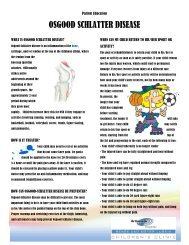“It's A Bargain” Thrift Shop - Orthopaedic Hospital
“It's A Bargain” Thrift Shop - Orthopaedic Hospital
“It's A Bargain” Thrift Shop - Orthopaedic Hospital
You also want an ePaper? Increase the reach of your titles
YUMPU automatically turns print PDFs into web optimized ePapers that Google loves.
2<br />
viewpoint<br />
Taking <strong>Orthopaedic</strong><br />
Education to New Levels<br />
By James V. Luck, Jr., MD • Chief Executive Officer and Medical Director • Los Angeles Orthopædic <strong>Hospital</strong><br />
This is an incredibly exciting time<br />
to be working in orthopaedics.<br />
For nearly 100 years, we at<br />
Orthopædic <strong>Hospital</strong> have been<br />
committed to improving care for<br />
people with all types of orthopaedic problems<br />
through patient care, research and education.<br />
Today, orthopaedic surgery represents one of<br />
the most competitive residencies across the<br />
United States. By combining the extraordinary<br />
academic credentials of both UCLA and<br />
Orthopædic <strong>Hospital</strong>, I believe that we soon<br />
will have the nation’s most sought-after orthopaedic<br />
residency.<br />
Education, of course, has long been part<br />
of the core mission of Orthopædic <strong>Hospital</strong>,<br />
along with providing charity care and advancing<br />
scientific research. Our medical residency<br />
program began with just a handful of residents<br />
in the 1940s under the guidance of our<br />
founder, Charles LeRoy Lowman, MD; Alvia<br />
Brockway, MD; and Ward Rowland, MD.<br />
When my father, J. Vernon<br />
Luck Sr., MD, became<br />
medical director in<br />
1955, the residency<br />
program was down to a<br />
single resident. Because one of my father’s priorities<br />
was education, he built one of the most<br />
robust and sought-after training programs in<br />
orthopaedics nationally.<br />
Some people have said he almost singlehandedly<br />
reinvented professional medical<br />
education. He challenged medical students<br />
and residents to be more than what he termed<br />
“surgical technicians.” He developed the<br />
<strong>Orthopaedic</strong> Resident Physician-In-Training<br />
Examination used in U.S. orthopaedic residency<br />
programs to assist residents and their<br />
professors in identifying gaps in their knowledge<br />
and assure uniform high standards.<br />
After my father completed his<br />
tenure in 1967, the residency<br />
program continued along<br />
a similar path until Augusto<br />
Sarmiento, MD was named<br />
medical director.<br />
Dr. Sarmiento was also the chairman of<br />
the Department of <strong>Orthopaedic</strong>s at the University<br />
of Southern California, which oversaw<br />
the Los Angeles County residency program.<br />
He combined that program with the OH residency<br />
under the auspices of USC. Orthopædic<br />
<strong>Hospital</strong> continued to play a significant role in<br />
the training of these residents but no longer<br />
had responsibility for the administration of<br />
the program as a whole.<br />
In the first years of the 1990s under the<br />
administration of Blair C. Filler, MD, director<br />
of Medical Education, other residencies began



